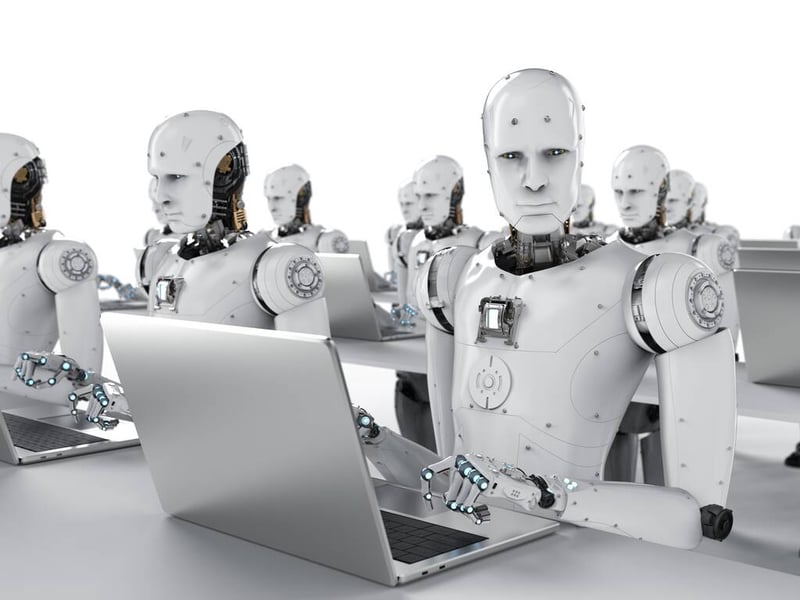What is a Digital Workforce? If you are in Shared Services, you are hearing this term all the time – most likely asking yourself: What is it exactly and how will it impact me?
These questions were answered most recently at the Shared Services & Outsourcing Conference in San Jose, California. Scott Madden’s Brad DeMent kicked off the event discussing trends they predict for 2019 and beyond based on a recent survey they completed. But before we jump into their findings, let’s remind ourselves what is “the digital workforce”?
Well, according to Deloitte, the digital workforce is “a virtual robot (software) that will be either working in the background or accessed by consumers and co-workers through a command based interface”. Most people think of it as software that automates repetitive, rules-based processes that are somewhat complex, and, dare I say….mundane.
So with that definition in mind, let’s take a closer look at the projected impact the digital workforce will have on Shared Service Centers in 2019 and beyond according to Scott Madden.

In the next few years, it is predicted that the digital workforce will:
1. Help Regional SSC’s Standardize Globally
According to the Scott Madden survey, Corporate giants think regional shared service centers are still the right business model for their large enterprise. However, there is a migration towards using intelligent automation (IA) and robotic process automation (RPA) platforms to help create global process standardization across these regional service centers. Of those surveyed, approximately 44% of large enterprise companies still operate with regional centers as opposed to 28% operating with a single global center.
In addition, the new digital workforce will help drive delivery centers to stay onshore because process automation enables the cost of services in the U.S. to be comparable to labor costs in places like India. As a result, only 21% of delivery centers are being located offshore, 20% are being located “nearshore”, and an amazing 46% are being located onshore.
2. Enable ‘First Contact’ Customer Service Ownership
The Scott Madden study indicates that 84% of top-quartile companies are staffing their shared service centers to own the “first contact” customer service within their own organization. This is because they want to be able to respond quickly and accurately to the business units. The digital workforce enables companies to ‘do more with less’ headcount and own the “first contact” interaction. For example, we are seeing virtual agents and chatbots qualify the initial inquiry and queue up information for GBS customer service agents. This digitization makes it easy for SSCs to own the customer service experience directly (as opposed to using BPO resources for first response).
3. Help Retain the Millennial
The Millennial's have brought creativity to the workplace, but the friction between generations (experience/ tenure) led companies to wonder what they needed to do to balance everyone’s needs? The successful recipe comes when companies provide more opportunities for learning; more flexibility and mobility for this generation. Millennial's don’t want mundane work, and RPA and other technologies are enabling the successful SSC to automate the repetitive work. The leading SSC’s have automated the routine tasks and are providing new opportunities to keep the younger generation stimulated and challenged – thus helping to keep them in important positions longer.
4. Create Higher Value Add Work
Scott Madden’s survey indicate that 40% of Finance and Accounting work activities and 30% of the HR work can be replaced by technology. For example, jobs that focus on looking at invoice error resolution, customer approval, expense report auditing, forecasting, planning and budget are all finance and accounting activities likely to go away with the introduction of intelligent automation.
But, when asked if they are ready, the surveyed enterprises stated they don’t have the right skill sets for IA and RPA - so where are they getting these skills? They are hiring service providers to implement these technologies. However, as corporate IT professionals evolve their skill set, it is predicted that “bot management” will migrate internally.
Reinforcing these projections, the survey indicates that 52% of companies state that they are not trying to replace employees with technology, but are instead are driving for better quality in operations (fewer errors in processing data.) Companies are using Intelligent Automation and RPA in forecasting and planning, tax planning, reporting, and security.
In fact, the Scott Madden team stated that Intelligent Automation will replace 1.8 million in old jobs but create 2.3 million in new jobs, thereby creating 500,000 net new jobs as a result of automation technology.
Did you know that…65% of kids entering grade-school now will be applying for jobs that don’t even exist today?
5. Changes the Value Proposition Discussion
The business value proposition is not all about labor savings anymore. As the digital workforce starts to embed itself in Shared Service Centers, non-labor savings – like avoiding bad debt, doing credit analysis, conducting audits and verifying compliance - is entering into the value proposition discussion. These factors are becoming part of the mainstream justification when looking at process automation and the digitization of the workforce.
Are you Ready?
So, are you getting ready for a Digital Workforce? If not, it’s time to start thinking about it. The Hackett Group indicates digital workforce roles for consideration include:
- Information management (e.g. security)
- Analytics & data scientists
- Change management project managers
- Customer-centric process architects
So, as a first step, make sure you are educating yourself and your IT department on digital transformation. Get familiar with automation technologies like Direct Commerce and others.
Then, benchmark against your peers and engage your employees to build a culture of innovation – you will need them to be part of the transformation!
Want to learn more? Contact us for a free Digital Needs Assessment to help you get started.

